Review: ‘Marvel Chronicle’
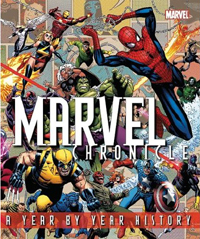 Marvel Comics kicks off their 70th Anniversary celebration with [[[Marvel Chronicle]]], a wonderful hardcover book, published by DK Publishing. The coffee table book comes in a hard box complete with color and black and white reproductions of Jim Cheung’s frenetic cover. (The diecut M for the front cover is a nice touch.) As is sadly too often the case these days Stan Lee’s introduction is full of bombast and enthusiasm but tells us nothing new.
Marvel Comics kicks off their 70th Anniversary celebration with [[[Marvel Chronicle]]], a wonderful hardcover book, published by DK Publishing. The coffee table book comes in a hard box complete with color and black and white reproductions of Jim Cheung’s frenetic cover. (The diecut M for the front cover is a nice touch.) As is sadly too often the case these days Stan Lee’s introduction is full of bombast and enthusiasm but tells us nothing new.
The book is a year by year account of the company from its humble beginnings as an offshoot of Martin Goodman’s pulp magazine line to its place atop the comic book heap in 2008. The book nicely spans from 1939 through June 2008 (following cover date convention). Each decade has been handled by one of four writers – Tom DeFalco, Peter Sanderson, Tom Brevoort, and Matthew K. Manning – and provides month by month highlights with copious illustrations.
The chapters on the 1940s (Sanderson) and the 1950s (Brevoort) are the most interesting in how they show the company’s breadth, lack of depth, and ability to flood the market with titles on whatever is popular at the moment. While it’s fascinating to see the seldom seen funny animals and teen humor characters slowly replace the super-heroes, it’s also interesting to note that after [[[Captain America]]], Sub-Mariner, and the Human Torch, the company failed to score another major hit character for decades. The write ups also nicely tell us which characters, creators or innovations get revived in the future.
Marvel, of course, finally came into its own with [[[Fantastic Four #1]]] and the set-up is wonderfully handled by Brevoort, who notes that when the company was forced to cut its output to eight titles a month, Stan Lee took the opportunity to get better as a writer, and use only his best artists – Jack Kirby, Steve Ditko, and Don Heck for the most part.


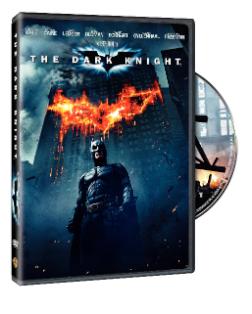
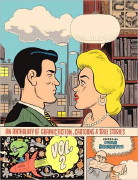
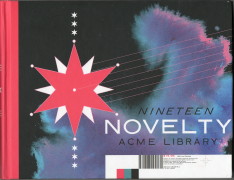
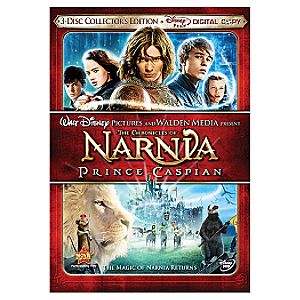 The biggest problem with the film version of [[[The Chronicles of Narnia]]] is that it cannot escape comparisons with [[[Lord of the Rings]]], much the same way the C.S. Lewis books were frequently measured against his contemporary, J.R.R. Tolkien.
The biggest problem with the film version of [[[The Chronicles of Narnia]]] is that it cannot escape comparisons with [[[Lord of the Rings]]], much the same way the C.S. Lewis books were frequently measured against his contemporary, J.R.R. Tolkien.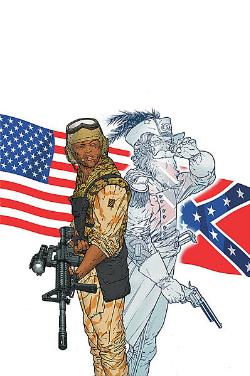 The [[[Haunted Tank]]] has to be one of the oddest war comics concepts ever published. A descendant of Civil War General JEB Stuart is haunted by the Virginian during World War II. While the rest of his crew thinks he’s got a screw loose, Jeb Stuart gains vital tactical knowledge and inspiration from the ghostly guardian and together they mowed down countless enemies in the pages of [[[G.I. Combat]]].
The [[[Haunted Tank]]] has to be one of the oddest war comics concepts ever published. A descendant of Civil War General JEB Stuart is haunted by the Virginian during World War II. While the rest of his crew thinks he’s got a screw loose, Jeb Stuart gains vital tactical knowledge and inspiration from the ghostly guardian and together they mowed down countless enemies in the pages of [[[G.I. Combat]]].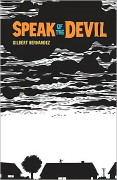
 Growing up, my animation was largely the Saturday morning variety, the Hanna-Barbera output where kids never questioned a talking penguin and walrus on globe-trotting adventures, receiving wisdom from a human professor with a magical chalkboard. As I grew up and animation evolved, I realized the kinds of cartoons were splintering for the variable demographics, a change largely brought about my the advent of cable television.
Growing up, my animation was largely the Saturday morning variety, the Hanna-Barbera output where kids never questioned a talking penguin and walrus on globe-trotting adventures, receiving wisdom from a human professor with a magical chalkboard. As I grew up and animation evolved, I realized the kinds of cartoons were splintering for the variable demographics, a change largely brought about my the advent of cable television.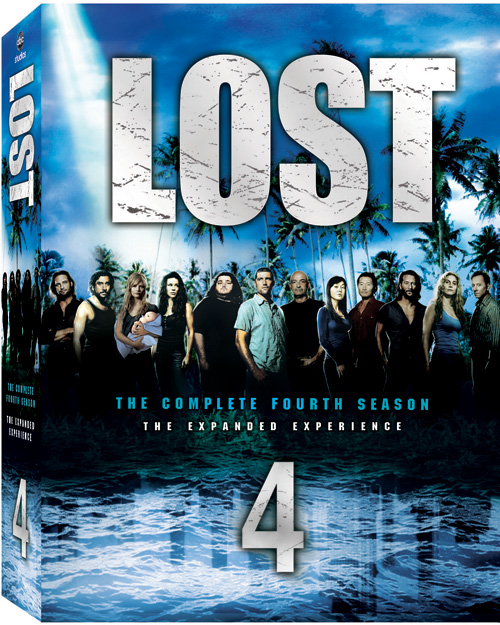
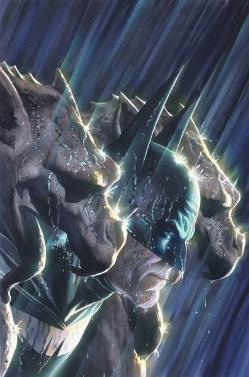 The nature of super-hero comics (and serial storytelling in TV as well) has become an incestuous thing, one that feeds on its own cast of characters, no matter how wrongheaded it might seem. In any given story arc, the reader (and the viewer) has been trained to expect The Last Person You’d Ever Expect (fill in the name of your favorite Beloved Supporting Character) to be revealed as the villainous mastermind. And/or salacious details about Our Hero. Dark secrets that threaten the very underpinnings of the lead characters’ being. The promise of certain death for players who’ve existed for decades. (No, really. We mean it!)
The nature of super-hero comics (and serial storytelling in TV as well) has become an incestuous thing, one that feeds on its own cast of characters, no matter how wrongheaded it might seem. In any given story arc, the reader (and the viewer) has been trained to expect The Last Person You’d Ever Expect (fill in the name of your favorite Beloved Supporting Character) to be revealed as the villainous mastermind. And/or salacious details about Our Hero. Dark secrets that threaten the very underpinnings of the lead characters’ being. The promise of certain death for players who’ve existed for decades. (No, really. We mean it!)








